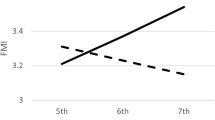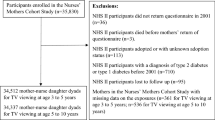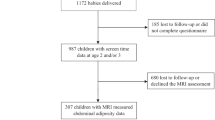Abstract
Objective:
To assess the impact of television viewing during childhood and adolescence on body mass index (BMI) in children up to the age of 15 years.
Design:
Unselected birth cohort, assessed at birth and every 2 years from age 3 to 15 years.
Subjects:
In all, 1037 individuals were assessed at age 3 years. At age 15 years, 976 (95% of living cohort) continued to participate.
Measurements:
Parental estimates of weekday television viewing between age 5 and 11 years. Self-reports of television viewing at age 13 and 15 years. Weight and height were measured at each age to calculate BMI.
Results:
BMI and prevalence of overweight at all ages were significantly associated with mean hours of television viewing reported in the assessments up to that age. These associations were stronger in girls than boys. The associations remained significant after adjusting for parental body mass indices and socio-economic status.
Conclusion:
Time spent watching television is a significant predictor of BMI and overweight in childhood. Although the effect size appears small, it is larger than the effect sizes commonly reported for nutritional intake and physical activity. Television viewing should be regarded as an important contributing factor to childhood obesity.
This is a preview of subscription content, access via your institution
Access options
Subscribe to this journal
Receive 12 print issues and online access
$259.00 per year
only $21.58 per issue
Buy this article
- Purchase on Springer Link
- Instant access to full article PDF
Prices may be subject to local taxes which are calculated during checkout
Similar content being viewed by others
References
Ebbeling CB, Pawlak DB, Ludwig DS . Childhood obesity: public-health crisis, common sense cure. Lancet 2002; 360: 473–482.
Marshall SJ, Biddle SJ, Gorely T, Cameron N, Murdey I . Relationships between media use, body fatness and physical activity in children and youth: a meta-analysis. Int J Obes Relat Metab Disord 2004; 28: 1238–1246.
Hancox RJ, Milne BJ, Poulton R . Association between child and adolescent television viewing and adult health: a longitudinal birth cohort study. Lancet 2004; 364: 257–262.
Silva PA, Stanton WR . From Child to Adult: The Dunedin Multidisciplinary Health and Development Study. Oxford University Press: Auckland, 1996.
Elley WB, Irving JC . The Elley–Irving socio-economic index 1981 census revision. NZ J Educ Stud 1985; 29: 115–128.
Cole TJ, Bellizzi MC, Flegal KM, Dietz WH . Establishing a standard definition for child overweight and obesity worldwide: international survey. BMJ 2000; 320: 1240–1243.
Cohen J . A power primer. Psychol Bull 1992; 112: 155–159.
Borzekowski DL, Robinson TN . Viewing the viewers: ten video cases of children's television viewing behaviours. J Broadcast Electron 1999; 43: 506–528.
Anderson DR, Field DE, Collins PA, Lorch EP, Nathan JG . Estimates of young children's time with television: a methodological comparison of parent reports with time-lapse video home observation. Child Dev 1985; 56: 1345–1357.
Rose G . Sick individuals and sick populations. Int J Epidemiol 1985; 14: 32–38.
Guillaume M, Lapidus L, Lambert A . Obesity and nutrition in children. The Belgian Luxembourg Child Study IV. Eur J Clin Nutr 1998; 52: 323–328.
Bogaert N, Steinbeck KS, Baur LA, Brock K, Bermingham MA . Food, activity and family – environmental vs biochemical predictors of weight gain in children. Eur J Clin Nutr 2003; 57: 1242–1249.
Maffeis C, Talamini G, Tatò L . Influence of diet, physical activity and parents' obesity on children's adiposity: a four-year longitudinal study. Int J Obes Relat Metab Disord 1998; 22: 758–764.
Kemper HC, Post GB, Twisk JW, van Mechelen W . Lifestyle and obesity in adolescence and young adulthood: results from the Amsterdam Growth And Health Longitudinal Study (AGAHLS). Int J Obes Relat Metab Disord 1999; 23 (Suppl 3): S34–S40.
Gortmaker SL, Dietz Jr WH, Cheung LW . Inactivity, diet, and the fattening of America. J Am Diet Assoc 1990; 90: 1247–1252, 1255.
Vincent SD, Pangrazi RP, Raustorp A, Tomson LM, Cuddihy TF . Activity levels and body mass index of children in the United States, Sweden, and Australia. Med Sci Sports Exerc 2003; 35: 1367–1373.
Graf C, Koch B, Kretschmann-Kandel E, Falkowski G, Christ H, Coburger S et al. Correlation between BMI, leisure habits and motor abilities in childhood (CHILT-project). Int J Obes Relat Metab Disord 2004; 28: 22–26.
Berkey CS, Rockett HR, Field AE, Gillman MW, Frazier AL, Camargo Jr CA et al. Activity, dietary intake, and weight changes in a longitudinal study of preadolescent and adolescent boys and girls. Pediatrics 2000; 105: E56.
Changing Home Environment 1975–2003 [Web Page]. Available at http://www.acnielsen.co.nz/MRI_pages.asp?MRIID=3, (accessed 29 November 2004).
Turnbull A, Barry D, Wickens K, Crane J . Changes in body mass index in 11–12-year-old children in Hawkes Bay, New Zealand (1989–2000). J Paediatr Child Health 2004; 40: 33–37.
Taras HL, Sallis JF, Patterson TL, Nader PR, Nelson JA . Television's influence on children's diet and physical activity. J Dev Behav Pediatr 1989; 10: 176–180.
Acknowledgements
The Dunedin Multidisciplinary Health and Development Research Unit is supported by the Health Research Council of New Zealand. We thank Dr Phil Silva, founder of the study and Air New Zealand. We also thank the Study members and their families for their participation and ongoing support.
Author information
Authors and Affiliations
Corresponding author
Rights and permissions
About this article
Cite this article
Hancox, R., Poulton, R. Watching television is associated with childhood obesity: but is it clinically important?. Int J Obes 30, 171–175 (2006). https://doi.org/10.1038/sj.ijo.0803071
Received:
Revised:
Accepted:
Published:
Issue Date:
DOI: https://doi.org/10.1038/sj.ijo.0803071
Keywords
This article is cited by
-
Urban park design and children’s physical activity levels: an investigation of design characteristics of green areas and playgrounds
Journal of Engineering and Applied Science (2022)
-
Associations between childhood overweight, obesity, abdominal obesity and obesogenic behaviors and practices in Australian homes
BMC Public Health (2018)
-
Family lifestyle dynamics and childhood obesity: evidence from the millennium cohort study
BMC Public Health (2018)
-
Sedentary behaviour and adiposity in youth: a systematic review of reviews and analysis of causality
International Journal of Behavioral Nutrition and Physical Activity (2017)
-
Canadian 24-hour movement guidelines for the early years (0–4 years): exploring the perceptions of stakeholders and end users regarding their acceptability, barriers to uptake, and dissemination
BMC Public Health (2017)



